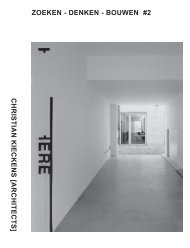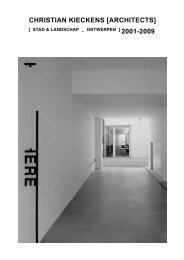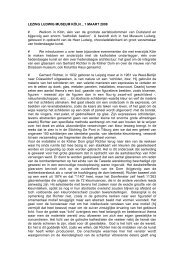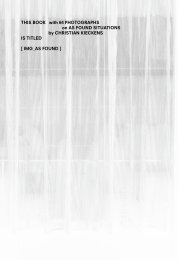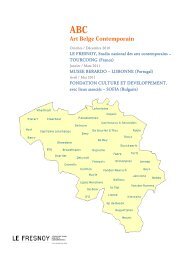download pdf - Christian Kieckens Architects
download pdf - Christian Kieckens Architects
download pdf - Christian Kieckens Architects
You also want an ePaper? Increase the reach of your titles
YUMPU automatically turns print PDFs into web optimized ePapers that Google loves.
Dear Lone, dear ladies and gentlemen,<br />
As an architect saying some words in a Danish institute is quite a nice task. As you<br />
maybe know, practically all architects all over the world started their job by playing<br />
with some colored blocks, for us the most famous Danish invention, thus taking into<br />
account the sentence as put by the company director, namely “Your imagination is<br />
the only restriction”!<br />
Asking people who the most famous people from Denmark are, one can notice that<br />
for architects it is Jacobsen and Utzon, for artists it is Olafur Eliasson, for furniture it<br />
is Kjaerholm and Wegner.<br />
But let’s mention some other people that aren’t immediately fitting in the framework<br />
of minimalist appearance: we can talk on Per Kirkeby and his hard to trace attitude<br />
going form brick works to rough paintings, on Verner Panton and his idea on<br />
changing the interior by the invention of new materials, on Joachim Koester and his<br />
ongoing research on connecting documents into art, or even Elmgreen and Dragset<br />
although one of them is Norwegian, and their controversial artistic work such as the<br />
“powerless structures”. You may notice hat these artist can’t easily be put under one<br />
single sign. And maybe this is the real Danish attitude we want to talk about at this<br />
occasion.<br />
The title of the exhibition for which reason we are here together is “PLAY BACK”. So,<br />
let’s first go back into our sequence of thoughts: ”LEGO” is derived from “Leg Godt’,<br />
or also to be interpreted as “I am reading” or “I am choosing”. The artist of the works<br />
as presented here – namely Mika Utzon-Popov - is the grandson of the famous<br />
architect Jorn Utzon, well-known for the Sidney Opera house, who once declared “I<br />
like to be on the edge of the possible”.<br />
I can imagine having the name of a well-known person doesn’t make it easily to start<br />
a proper work, nor to survive. It is the hardest thing to do getting any individual<br />
research, something for yourself that offers a visual journey through life’s physical<br />
space as the artist mentions.<br />
I especially like the theme of “Play.back”: the connotation helps me to go deeper into<br />
the work. Play back is split in two words: play and back. But what we see is not a<br />
simple thought of ‘play’ or of ‘back’. “Play” is the mindful world of moving images;<br />
“back” is the notion that, once something is drawn on paper, it only can be about
“back”. Every reading of ours on every work of art is taking the notion of ‘going back’<br />
because an artist is always the first to state something into his work.<br />
”Once you draw a landscape, it becomes part of your physical memory” states Mika<br />
Utzon-Popov. In his recent works he’s searching for the inherent labyrinths of<br />
memory. This is the real thing what the work is about: the labyrinth of our reflections<br />
and the memory that helps us in surviving in life.<br />
Drawing is thus becoming an essential part of the artist life. He’s fragmenting<br />
cityscapes and is putting them together, in different layers over each other or next to<br />
each other. In this way every drawing is more than just one simple image, more then<br />
just one focus: it is an assemblage of scapes and shapes, of pointed views, of<br />
different layers creating a completeness.<br />
This exhibition offers us a recent overview of a narrative journey. We almost forget<br />
that we need something next to the functional, next to the lively necessary. Here in<br />
Play.back we can trace an attitude of that elusive thing in life. Visually in the first<br />
look, intelligent in the second, and even more maybe intellectual when studying the<br />
works, they become part into our private memory. And here the most important thing<br />
is happening: the way the works are finding a “place” into our minds, into our<br />
memory. They produce a mental reproduction.<br />
The whole globe is the proper world of Mika Utzon-Popov. Such as emotions, sounds<br />
and images are explaining an international all over language, the drawings are a<br />
result of “moving”. To me MOVING is the key concept in the work: as the artist was<br />
moving all over the world, his work is moving us for getting us moved.<br />
Ladies and gentlemen: “Your imagination is the only restriction” was the motto by<br />
Lego. But here we do see “imagination” as placed in some other context: not in the<br />
formal expression by creating objects, but in the way ‘to play back’ thus becoming a<br />
subject pushing us on the edge of the possible as Jorn Utzon would have said. Place<br />
is becoming here 'displace': topos is thus an anatopos, in the aim of moving us<br />
towards our proper labyrinthine memory.<br />
We can’t do otherwise. And we are happy we can take part in it: “Det bedste er ikke<br />
for godt” (only the best is good enough).
Dear Lone, thanks for the invitation. Dear audience, please enjoy the fantastic world<br />
of the works of Utzon-Popov. Many thanks.<br />
<strong>Christian</strong> <strong>Kieckens</strong>, 2009 10 27



